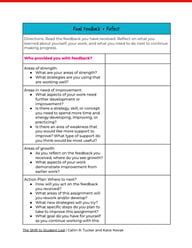Productive struggle is a concept best described as a person's ability to work through a problem to find a solution or complete a task. Productive struggle is a good thing! “Getting it” isn’t always easy, but in reality, learning will be more profound if our students have to work a bit harder to build their knowledge and skills.
It is important that we help our students learn how to persist through the process and develop the grit necessary to succeed. As such, productive struggle is an inherent part of all learning, Universal Design for Learning (UDL), and an essential skill for becoming an expert learner. Productive struggle is not a new concept, and it has been around since Plato, Rousseau, and Dewey (Murdoch et al., 2021), but it has been talked about a lot lately. Vygotsky's Zone of Proximal Development emphasizes the assistance teachers can provide in this process by connecting the current lesson to background knowledge and providing lessons that are challenging or, to paraphrase Vygotsky, to give students assignments and lessons that are just beyond their range of ability.
When you look at productive struggle through a UDL lens, you see that it is really about supporting your students' engagement and empowering them to persist until they meet the learning goal. CAST describes the engagement principle as the affective component of learning:
Affect represents a crucial element to learning, and learners differ markedly in the ways in which they can be engaged or motivated to learn. There are a variety of sources that can influence individual variation in affect including neurology, culture, personal relevance, subjectivity, and background knowledge, along with a variety of other factors. Some learners are highly engaged by spontaneity and novelty while others are disengaged, even frightened, by those aspects, preferring strict routine. Some learners might like to work alone, while others prefer to work with their peers. In reality, there is not one means of engagement that will be optimal for all learners in all contexts; providing multiple options for engagement is essential.
So, if we need to let our students experience challenges, frustration, and struggle, we need to let them do the work and not jump in too soon to help them. If we jump in too soon, we will end up teaching them the exact opposite of what we want them to learn by implying that they can’t do it on their own. How can we help our students develop this critical skill? Read on.
6 Ways to Encourage Productive Struggle in Your Classroom
2. Present a problem with various options and step back to allow students to work through it on their own. This will optimize choice and autonomy as well as tell your students that you believe in their ability to do this work. You will obviously be there if your students need help, but you want to make sure that they know it is their job to do this work. For example, imagine a science teacher assigns a lab report and prompts the students with a challenge instead of providing direct instruction: "In groups, discuss and determine the significance of sharing your findings with the scientific community. Identify the essential components of a lab report and strategize on how you can adhere to the highest standards in your presentation." This approach not only fosters autonomy and critical thinking but signals to the students the teacher's confidence in their abilities to tackle complex tasks.
3. Plan to practice the skill or concept over time using multiple means to limit burnout and give students opportunities to manage their process. Repetition, by itself, can get pretty dull, but extended practice of the same concepts in different ways can reinforce the goals and objectives of the lesson and vary the demands and resources to optimize the challenges. For example, after teaching figurative language, you can introduce an engaging activity focused on understanding figurative language once a week, but each time in a new format to keep interest high and burnout low. One day, it might be a short quiz game on a digital platform like Kahoot, where students identify types of figurative language in various sentences or song lyrics. Another day, switch to a more reflective approach, such as journaling prompts asking students to write their own examples of metaphors or similes based on their experiences or feelings. Later, students could work in small groups to create a vignette incorporating as many figurative language examples as possible. You can also practice over time by interleaving or weaving new lessons with previous learning. For instance, consider an elementary classroom that covered the American Revolution in social studies earlier in the year. A few months later, as the class delves into reading an excerpt of "Johnny Tremain," a novel set in the same historical period, the teacher can strategically reintegrate aspects of their earlier studies to deepen comprehension and engagement.
4. Support mindfulness by transforming your classroom into a haven for focused learning. If you see your students experiencing stress, help to minimize any threats and distractions by:
-
- asking them what the problem is, clarifying the objectives, explaining the vocabulary, reviewing background knowledge, and reviewing the instructions as necessary to help them overcome the barriers (this will help to break through unproductive struggle).
- providing options for students to self-regulate their emotional state throughout the lesson (i.e., breathing, taking a break, going to a “peace corner”),
- offering visual reminders,
- modeling the practices yourself. We love Brene Brown’s box breathing technique (visual at left, Science of Connectedness, 2019). Demonstrate it for your class and then encourage them to try it for themselves!

6. Reflect, refine, and repeat to let the students dig deep and “help build students’ ability to recognize and steer themselves back to a place of productive struggle.” For a student to really learn something, they have to be able to recognize that they have learned something, and the only way that they are going to do that is by self-assessing their work and reflecting on the outcome. In their book The Shift to Student Led, Catlin Tucker, and Katie Novak offer a great graphic organizer (make a copy) for managing this process. This also asks the students to “do something” with the feedback to reflect and deepen their learning.
Productive struggle is an important part of learning and a true life skill, and believe me, as a retired educator, this is NOT anything new. I remember getting my first video production job at Texas Instruments in 1979. I was fresh out of grad school and had never experienced or been trained in the process of assembling equipment to edit videotape (yeah, it was that long ago). But there I was, on my first day at work, tasked with the challenge of putting all the gear together to edit my first project...without any help! With a bit of effort, research, and persistence, I got it done. I should have contacted the nuns at St. Cecilia’s grammar school to thank them for helping me learn how to persist!
Continue Your Learning!
Discover professional development options universally designed for all learners. Gain the tools and strategies you need to be wildly successful - no barriers, no excuses. Learn more.



